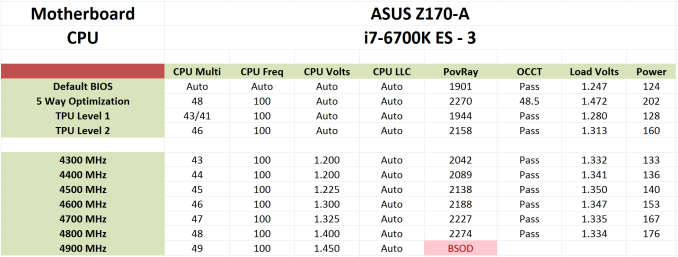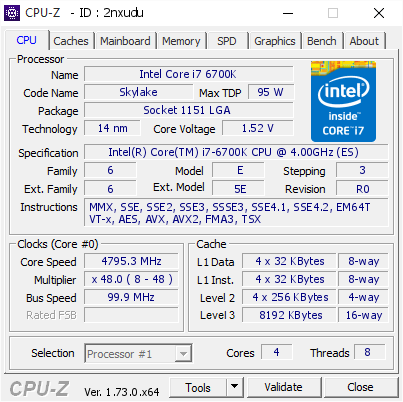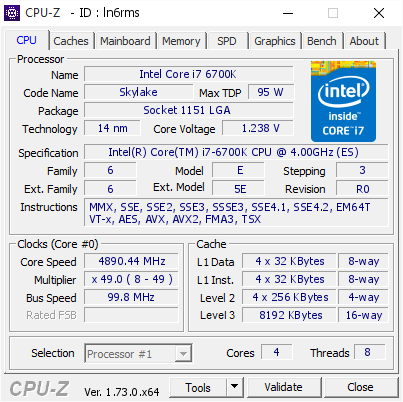The Intel Skylake i7-6700K Overclocking Performance Mini-Test to 4.8 GHz
by Ian Cutress on August 28, 2015 2:30 PM EST
At the time of our Skylake review of both the i7-6700K and the i5-6600K, due to the infancy of the platform and other constraints, we were unable to probe the performance uptake of the processors as they were overclocked. Our overclock testing showed that 4.6 GHz was a reasonable marker for our processors; however fast forward two weeks and that all seems to change as updates are released. With a new motherboard and the same liquid cooler, the same processor that performed 4.6 GHz gave 4.8 GHz with relative ease. In this mini-test, we tested our short-form CPU workload as well as integrated and discrete graphics at several frequencies to see where the real gains are.
In the Skylake review we stated that 4.6 GHz still represents a good target for overclockers to aim for, with 4.8 GHz being indicative of a better sample. Both ASUS and MSI have also stated similar prospects in their press guides that accompany our samples, although as with any launch there is some prospect that goes along with the evolution of understanding the platform over time.
In this mini-test (performed initially in haste pre-IDF, then extra testing after analysing the IGP data), I called on a pair of motherboards - ASUS's Z170-A and ASRock's Z170 Extreme7+ - to provide a four point scale in our benchmarks. Starting with the 4.2 GHz frequency of the i7-6700K processor, we tested this alongside every 200 MHz jump up to 4.8 GHz in both our shortened CPU testing suite as well as iGPU and GTX 980 gaming. Enough of the babble – time for fewer words and more results!


We actually got the CPU to 4.9 GHz, as shown on the right, but it was pretty unstable for even basic tasks.
(Voltage is read incorrectly on the right.)
OK, a few more words before results – all of these numbers can be found in our overclocking database Bench alongside the stock results and can be compared to other processors.
Test Setup
| Test Setup | |
| Processor | Intel Core i7-6700K (ES, Retail Stepping), 91W, $350 4 Cores, 8 Threads, 4.0 GHz (4.2 GHz Turbo) |
| Motherboards | ASUS Z170-A ASRock Z170 Extreme7+ |
| Cooling | Cooler Master Nepton 140XL |
| Power Supply | OCZ 1250W Gold ZX Series Corsair AX1200i Platinum PSU |
| Memory | Corsair DDR4-2133 C15 2x8 GB 1.2V or G.Skill Ripjaws 4 DDR4-2133 C15 2x8 GB 1.2V |
| Memory Settings | JEDEC @ 2133 |
| Video Cards | ASUS GTX 980 Strix 4GB ASUS R7 240 2GB |
| Hard Drive | Crucial MX200 1TB |
| Optical Drive | LG GH22NS50 |
| Case | Open Test Bed |
| Operating System | Windows 7 64-bit SP1 |
The dynamics of CPU Turbo modes, both Intel and AMD, can cause concern during environments with a variable threaded workload. There is also an added issue of the motherboard remaining consistent, depending on how the motherboard manufacturer wants to add in their own boosting technologies over the ones that Intel would prefer they used. In order to remain consistent, we implement an OS-level unique high performance mode on all the CPUs we test which should override any motherboard manufacturer performance mode.
Many thanks to...
We must thank the following companies for kindly providing hardware for our test bed:
Thank you to AMD for providing us with the R9 290X 4GB GPUs.
Thank you to ASUS for providing us with GTX 980 Strix GPUs and the R7 240 DDR3 GPU.
Thank you to ASRock and ASUS for providing us with some IO testing kit.
Thank you to Cooler Master for providing us with Nepton 140XL CLCs.
Thank you to Corsair for providing us with an AX1200i PSU.
Thank you to Crucial for providing us with MX200 SSDs.
Thank you to G.Skill and Corsair for providing us with memory.
Thank you to MSI for providing us with the GTX 770 Lightning GPUs.
Thank you to OCZ for providing us with PSUs.
Thank you to Rosewill for providing us with PSUs and RK-9100 keyboards.










103 Comments
View All Comments
Zoeff - Friday, August 28, 2015 - link
As an owner of a 6700K that's running at 4.8GHz, this is a very interesting article for me. :)I've currently entered 1.470v in the UEFI and I can get up to 1.5v in CPUz. Anything lower and it becomes unstable. So I guess I'm probably on the high side voltage wise...
zepi - Friday, August 28, 2015 - link
Sounds like a scorching voltage for 24/7 operations considering it is 14nm process... But obviously, we don't really know if this is detrimental on longer term.0razor1 - Friday, August 28, 2015 - link
I believe it is. Ion shift. High voltage = breakdown at some level. Enough damage and things go amiss.When one considers 1.35+ for 22nm high, I wonder why we're doing this (1.35+) at 14nm.
If it's OK, then can someone illustrate why one should not go over say 1.6V on the DRAM in 22nm, why stick to 1.35V for 14nm? Might as well use standard previous generation voltages and call it a day?
Further, where are the AVX stable loads? Sorry, but no P95 small in place FFTs with AVX = NOT stable enough for me. It's not the temps ( I have an h100i) for sure. For example, on my 4670k, it takes 1.22VCore for 4.6GHz, but 1.27VCore when I stress with AVX loads ( P95 being one of them).
It's *not* OK to say hey that synthetic is too much of a stress etc. I used nothing but P95 since K-10 and haven't found a better error catcher.
0razor1 - Friday, August 28, 2015 - link
To add to the above, downclocking the core on GPU's and running memcheck in OCCT is *it* for my VRAM stability tests when I OC my graphics cards. I wonder how people just 'look' for corruption in benchmarks like firestrike and call their OC's stable. It doesn't work.Run a game and leave it idle for ~ 10 hours and come back. You will find glitches all over the place on your 'stable' OC.
Just sayin- OC stability testing has fallen to new lows in the recent past, be it graphic cards or processors.
Zoeff - Friday, August 28, 2015 - link
I tend to do quick tests such as Cinebench 15 and HandBrake, then if that passes I just run it for a week with regular usage such as gaming and streaming. If it blue screens or I get any other oddities I raise the voltage by 0.01v. I had to do that twice in the space of 1 week (started at 1.45v, 4.8GHz)Oxford Guy - Saturday, August 29, 2015 - link
That's a great way to corrupt your OS and programs.Impulses - Saturday, August 29, 2015 - link
Yeah I do all my strenuous testing first, if I have to simulate real world conditions by leaving two tests running simultaneously I do it too... Like running an encode with Prime in the background; or stressing the CPU, GPU, AND I/O simultaneously.AFTER I've done all that THEN I'll restore a pre-tinkering OS image, unless I had already restored one after my last BSOD or crash... Which I'll do sometimes mid-testing if I think I've pushed the OC far enough that anything might be hinky.
It's so trivial to work with backups like that, should SOP.
Oxford Guy - Sunday, August 30, 2015 - link
If a person is using an unstable overclock for daily work it may be hard to know if stealth corruption is happening.kuttan - Sunday, August 30, 2015 - link
haha that is funny.kmmatney - Saturday, September 19, 2015 - link
I do the same as the OP (but use Prime95 and Handbrake). If it passes a short test there (say one move in Handbrake) I just start using the machine. I've had blue screens, but never any corruption issues. I guess corruption could happen, but the odds are pretty low. My computer gets backed up every night to a WHS server, so I can be fearless..